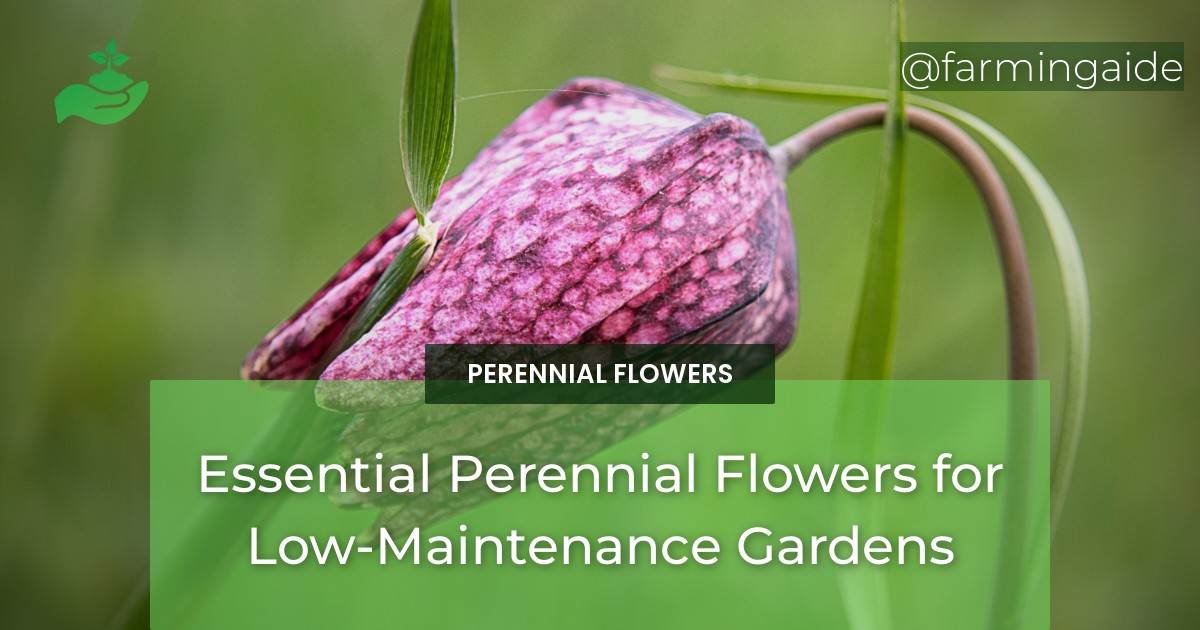If you want to make your garden beautiful without spending too much time on it, low-maintenance perennial flowers are the way to go. Perennial flowers bloom year after year and require minimal care, making them perfect for busy gardeners or those who just prefer to spend less time working in the garden. But with so many options to choose from, it can be difficult to know where to start. In this article, we will cover essential perennial flowers for low-maintenance gardens, factors to consider when choosing perennial flowers, how to care for low-maintenance perennial flowers, design tips for low-maintenance perennial gardens, and the benefits of low-maintenance perennial gardens.
Best Low-Maintenance Perennial Flowers
Black-Eyed Susan
Black-eyed Susan is a classic and popular perennial flower that blooms from mid-summer to fall. This flower is easy to care for and can grow up to three feet tall. Black-eyed Susan thrives in full sun and well-drained soil and attracts butterflies and bees to the garden.
Daylily
Daylilies are another popular choice for low-maintenance gardens. They come in many colors and bloom from late spring to early fall. Daylilies prefer full sun to partial shade and well-drained soil. These flowers can grow up to three feet tall and attract hummingbirds and butterflies.
Russian Sage
Russian sage is a drought-tolerant perennial flower that produces purple-blue flowers from mid-summer to fall. This flower can grow up to five feet tall and prefers full sun and well-drained soil. Russian sage is also deer-resistant and attracts bees and butterflies to the garden.
Coneflower
Coneflowers are another low-maintenance perennial flower that blooms from mid-summer to fall. They come in many colors, including pink, purple, and white. Coneflowers prefer full sun and well-drained soil and can grow up to four feet tall. These flowers also attract butterflies and birds to the garden.
Sedum
Sedum, also known as stonecrop, is a succulent perennial flower that requires almost no care and can withstand drought and poor soil. Sedum blooms in late summer and fall and comes in many colors, including pink, yellow, and white. These flowers grow up to two feet tall and attract butterflies to the garden.
Factors to Consider When Choosing Perennial Flowers
Soil Type
When choosing low-maintenance perennial flowers, it’s important to consider the soil type in your garden. Some perennial flowers prefer well-drained soil, while others can tolerate poor soil. Make sure to choose flowers that are well-suited for your garden’s soil type to ensure they thrive.
Light Exposure
Most perennial flowers prefer full sun to partial shade, while some can tolerate full shade. Consider the amount of light your garden receives when choosing low-maintenance perennial flowers to ensure they get the light they need to thrive.
Watering Needs
Low-maintenance perennial flowers are typically drought-tolerant and require minimal watering. However, it’s still important to choose flowers that are well-suited to your garden’s water needs. Some perennial flowers can tolerate dry soil, while others prefer moist soil.
Climate
Perennial flowers have different climate requirements, so it’s important to choose flowers that are well-suited for your climate. Some flowers can tolerate cold winters, while others prefer warm weather.
ALSO READ
How to Care for Low-Maintenance Perennial Flowers
Watering
Low-maintenance perennial flowers typically require minimal watering once they are established. However, it’s important to water them deeply during dry spells to ensure they stay healthy. Watering deeply encourages the plants to grow deeper roots, which makes them more drought-tolerant in the long run.
Fertilizing
Perennial flowers typically don’t require much fertilization, but it can help them grow and thrive. Use a slow-release fertilizer in the spring or fall to give your low-maintenance perennial flowers a boost.
Mulching
Mulching around your low-maintenance perennial flowers can help retain moisture in the soil, suppress weeds, and regulate soil temperature. Use a layer of organic mulch, such as shredded leaves or straw, around the base of your plants.
Deadheading
Deadheading, or removing spent flowers, can help encourage your low-maintenance perennial flowers to produce more blooms. It also keeps the plants looking neat and tidy. Use shears or scissors to cut off the spent flowers just above the nearest leaf.
Design Tips for Low-Maintenance Perennial Gardens
Grouping Plants
Grouping low-maintenance perennial flowers together can create a beautiful and low-maintenance garden. Choose flowers that bloom at different times of the year to ensure there is always something in bloom.
Creating Layers
Creating layers in your low-maintenance perennial garden can add depth and texture. Use taller plants in the back of the garden and shorter plants in the front to create a natural-looking garden.
Maximizing Space
If you have a small garden, consider using containers or raised beds to maximize space. You can plant low-maintenance perennial flowers in containers or raised beds to create a beautiful garden without taking up too much space.
ALSO READ
Benefits of Low-Maintenance Perennial Gardens
Cost-Effective
Low-maintenance perennial gardens can be cost-effective because you don’t need to replace the plants every year. Once the plants are established, they will continue to bloom year after year with minimal care.
Eco-Friendly
Low-maintenance perennial gardens are eco-friendly because they require minimal watering and fertilizing. They also attract pollinators to the garden, which is beneficial for the environment.
Attract Pollinators
Low-maintenance perennial flowers attract pollinators to the garden, such as bees, butterflies, and hummingbirds. This can help promote biodiversity in your garden and benefit the environment.
Conclusion
Low-maintenance perennial flowers are a great option for busy gardeners or those who prefer to spend less time working in the garden. When choosing low-maintenance perennial flowers, consider factors such as soil type, light exposure, watering needs, and climate. To care for low-maintenance perennial flowers, water deeply during dry spells, fertilize occasionally, mulch to retain moisture, and deadhead spent flowers. Design your low-maintenance perennial garden by grouping plants, creating layers, and maximizing space. The benefits of low-maintenance perennial gardens include cost-effectiveness, eco-friendliness, and attraction of pollinators to the garden.


